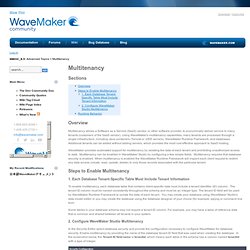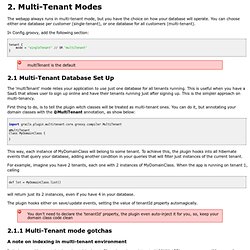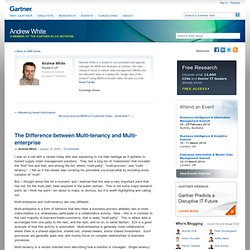

Multitenancy. Sections Overview Multitenancy allows a Software as a Service (SaaS) vendor, or other software provider, to economically deliver service to many tenants (customers of the SaaS vendor).

Using WaveMaker's multitenancy capabilities, many tenants are processed through a single infrastructure, including Java containers (Tomcat or J2EE servers), WaveMaker Runtime Framework, and databases. Additional tenants can be added without adding servers, which provides the most cost effective approach to SaaS hosting. WaveMaker provides automated support for multitenancy by isolating the data of each tenant and prohibiting unauthorized access to data. Steps to Enable Multitenancy 1. To enable multitenancy, each database table that contains client-specific data must include a tenant identifier (ID) column.
Some tables in your database schema may not require a tenant ID column. 2. Runtime Behavior A user must login to access the application. The diagram below outlines a basic interaction. Multi-tenancy in Cloud-based Collaboration Services-HPL-2009-17_百度文库. 2. Multi-Tenant Modes. The webapp always runs in multi-tenant mode, but you have the choice on how your database will operate.

You can choose either one database per customer (single-tenant), or one database for all customers (multi-tenant). In Config.groovy, add the following section: tenant { mode = "singleTenant" // OR "multiTenant" } multiTenant is the default 2.1 Multi-Tenant Database Set Up The 'multiTenant' mode relies your application to use just one database for all tenants running. The Difference between Multi-tenancy and Multi-enterprise. Andrew White Research VP 8 years at Gartner 22 years IT industry Andrew White is a research vice president and agenda manager for MDM and Analytics at Gartner.

His main research focus is master data management (MDM) and the drill-down topic of creating the "single view of the product" using MDM of product data. He was co-chair… Read Full Bio Coverage Areas: by Andrew White | August 19, 2009 | 2 Comments I was on a call with a vendor today who was explaining to me their heritage as it pertains to hosted supply chain management solutions. But, I thought about this for a moment, and I realized that this was a very important point that has not, for the most part, been explored in the public domain. Multi-enterprise and multi-tenancy are very different.
Multi-enterprise is a form of behavior that describes a business process whereby two or more stake-holders (i.e. enterprises) participate in a collaborative activity. Multi-tenancy is a vendor oriented term describing how a solution is managed. Force_Multitenancy_WP_101508. 使用 IBM 中间件实现 SaaS 解决方案,第 1 部分: 挑战和体系结构模式. Introduction to Multi-Tenant Architecture. Have you ever built multiple websites that have similar core functionality but really differ only in a few ways, such as layout and UI?

This can be costly and time consuming. Instead of copying and pasting code, giving it different namespaces, and then setting each to a different site name, I will discuss an architecture concept referred to as Multi-Tenant Websites, which helps improve upon the scenario I just mentioned. These websites allow developers to create a multitude of sites with slight discrepancies, while maintaining a shared code-base and appearing different to the end-user. I will go into the main concepts that the Multi-Tenant Architecture Utilizes and show some examples of these. Tenants The first piece to start with is having a table in your database to map each tenant (NOTE: When I refer to "Tenant," this term can be used interchangeable with "Website" to limit confusion) to an ID. Figure 1: Table Containing List of Tenants using the website. App URL and App Settings.